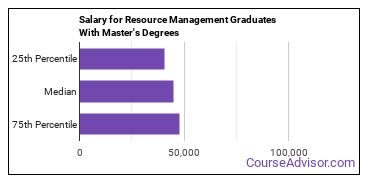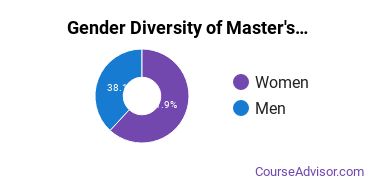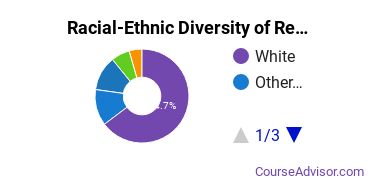Master’s Degrees in Natural Resource Management
Featured schools near , edit
Education Levels of Resource Management Majors
During the 2020-2021 academic year, 826 students earned their master's degree in resource management. This makes it the 127th most popular master's degree program in the country.
The following table shows the number of diplomas awarded in resource management at each degree level.
| Education Level | Number of Grads |
|---|---|
| Bachelor’s Degree | 1,383 |
| Master’s Degree | 826 |
| Graduate Certificate | 228 |
| Basic Certificate | 210 |
| Associate Degree | 200 |
| Undergraduate Certificate | 67 |
| Doctor’s Degree | 19 |
Earnings of Resource Management Majors With Master’s Degrees
The median salary for graduates holding a master's degree in resource management is $45,074. A lot of factors can contribute to this number, such as the location of your workplace and the availability of other perks and bonuses. To get a better picture, earnings for this category of people can range from a low of $40,824 to a high of $47,759.

Student Debt
We do not have the data to estimate the median debt for this class of people.
Student Diversity
More women than men pursue their master's degree in resource management. About 61.9% of graduates with this degree are female.
| Gender | Number of Grads |
|---|---|
| Men | 315 |
| Women | 511 |

The racial-ethnic distribution of resource management master’s degree students is as follows:
| Race/Ethnicity | Number of Grads |
|---|---|
| Asian | 15 |
| Black or African American | 36 |
| Hispanic or Latino | 97 |
| White | 525 |
| International Students | 52 |
| Other Races/Ethnicities | 101 |

Most Popular Resource Management Programs for Master’s Degrees
There are 61 colleges that offer a master’s degree in resource management. Learn more about the most popular 20 below:
The most popular school in the United States for resource management students seekinga master's degree is University of Denver. Each year, around 13,800 students seeking various degrees attend the university. The average in-state tuition for full-time undergraduates is $53,640 per year, while in-state graduate students, on average, pay $53,640 per year. For the 2020-2021 academic year, 137 master's degrees were handed out to resource management majors at DU. Around 27% of these students were from an underrepresented racial-ethnic group, and 58% were women.
American Public University System is the 2nd most popular school in the nation for students seeking a master's degree in resource management. Each year, around 50,000 students seeking various degrees attend the university. The average in-state tuition for full-time undergraduates is $6,840 per year, while in-state graduate students, on average, pay $6,660 per year. The resource management program at American Public University System awarded 111 master's degrees during the 2020-2021 school year. Of these students, 59% were women and 19% were members of underrepresented racial-ethnic groups.
Colorado State University - Fort Collins comes in at #3 on our list of the most popular colleges offering master's degrees in resource management. Roughly 32,400 attend the school each year. The average in-state tuition for full-time undergraduates is $9,709 per year, while in-state graduate students, on average, pay $10,834 per year. The resource management program at Colorado State University - Fort Collins awarded 84 master's degrees during the 2020-2021 school year. Of these students, 69% were women and 15% were members of underrepresented racial-ethnic groups.
The 4th most popular school in the country for resource management majors who are seeking their master's degree is Virginia Tech. Roughly 37,000 attend the school each year. The average in-state tuition for full-time undergraduates is $11,750 per year, while in-state graduate students, on average, pay $14,098 per year. During the 2020-2021 academic year, 72 people received their master's degree in resource management from Virginia Tech. Of these students, 56% were women and 19% were members of underrepresented racial-ethnic groups.
The 5th most popular school in the country for resource management majors who are seeking their master's degree is Oregon State University. Each year, around 32,300 students seeking various degrees attend the university. The average in-state tuition for full-time undergraduates is $10,065 per year, while in-state graduate students, on average, pay $13,446 per year. The resource management program at Oregon State University awarded 45 master's degrees during the 2020-2021 school year. Around 18% of these students were from an underrepresented racial-ethnic group, and 69% were women.
University of Miami comes in at #6 on our list of the most popular colleges offering master's degrees in resource management. Each year, around 17,800 students seeking various degrees attend the university. The average in-state tuition for full-time undergraduates is $53,112 per year, while in-state graduate students, on average, pay $39,834 per year. The resource management program at University of Miami awarded 44 master's degrees during the 2020-2021 school year. Of these students, 73% were women and 18% were members of underrepresented racial-ethnic groups.
University of Idaho is the 7th most popular school in the nation for students seeking a master's degree in resource management. Roughly 10,700 attend the school each year. The average in-state tuition for full-time undergraduates is $6,182 per year, while in-state graduate students, on average, pay $7,754 per year. The resource management program at University of Idaho awarded 25 master's degrees during the 2020-2021 school year. About 56% of this group were women, and 20% were students from an underrepresented racial-ethnic group.
University of Rhode Island is the 8th most popular school in the nation for students seeking a master's degree in resource management. Each year, around 17,600 students seeking various degrees attend the university. The average in-state tuition for full-time undergraduates is $13,250 per year, while in-state graduate students, on average, pay $14,454 per year. For the 2020-2021 academic year, 20 master's degrees were handed out to resource management majors at URI. Around 5% of these students were from an underrepresented racial-ethnic group, and 60% were women.
Lipscomb University comes in at #9 on our list of the most popular colleges offering master's degrees in resource management. Roughly 4,800 attend the school each year. The average in-state tuition for full-time undergraduates is $33,012 per year, while in-state graduate students, on average, pay $17,100 per year. The resource management program at Lipscomb University awarded 17 master's degrees during the 2020-2021 school year. Around 29% of these students were from an underrepresented racial-ethnic group, and 47% were women.
The 9th most popular school in the country for resource management majors who are seeking their master's degree is University of Hawaii at Manoa. Each year, around 18,000 students seeking various degrees attend the university. The average in-state tuition for full-time undergraduates is $11,304 per year, while in-state graduate students, on average, pay $15,600 per year. The resource management program at University of Hawaii at Manoa awarded 17 master's degrees during the 2020-2021 school year. Around 47% of these students were from an underrepresented racial-ethnic group, and 82% were women.
University of Maryland - College Park comes in at #11 on our list of the most popular colleges offering master's degrees in resource management. Roughly 40,700 attend the school each year. The average in-state tuition for full-time undergraduates is $9,000 per year, while in-state graduate students, on average, pay $15,360 per year. During the 2020-2021 academic year, 16 people received their master's degree in resource management from UMCP. Of these students, 44% were women and 38% were members of underrepresented racial-ethnic groups.
Montana State University is the 12th most popular school in the nation for students seeking a master's degree in resource management. Roughly 16,200 attend the school each year. The average in-state tuition for full-time undergraduates is $5,654 per year, while in-state graduate students, on average, pay $5,089 per year. During the 2020-2021 academic year, 15 people received their master's degree in resource management from MSU Bozeman. About 73% of this group were women, and 20% were students from an underrepresented racial-ethnic group.
Duke University is the 13th most popular school in the nation for students seeking a master's degree in resource management. Each year, around 16,100 students seeking various degrees attend the university. The average in-state tuition for full-time undergraduates is $58,085 per year, while in-state graduate students, on average, pay $57,900 per year. For the 2020-2021 academic year, 14 master's degrees were handed out to resource management majors at Duke. Around 14% of these students were from an underrepresented racial-ethnic group, and 71% were women.
North Dakota State University - Main Campus is the 13th most popular school in the nation for students seeking a master's degree in resource management. Roughly 12,800 attend the school each year. The average in-state tuition for full-time undergraduates is $8,951 per year, while in-state graduate students, on average, pay $7,293 per year. The resource management program at North Dakota State University - Main Campus awarded 14 master's degrees during the 2020-2021 school year. Around 14% of these students were from an underrepresented racial-ethnic group, and 29% were women.
Michigan State University comes in at #13 on our list of the most popular colleges offering master's degrees in resource management. Roughly 49,600 attend the school each year. The average in-state tuition for full-time undergraduates is $15,966 per year, while in-state graduate students, on average, pay $19,714 per year. For the 2020-2021 academic year, 14 master's degrees were handed out to resource management majors at Michigan State. Around 7% of these students were from an underrepresented racial-ethnic group, and 86% were women.
Florida International University is the 16th most popular school in the nation for students seeking a master's degree in resource management. Each year, around 58,800 students seeking various degrees attend the university. The average in-state tuition for full-time undergraduates is $4,721 per year, while in-state graduate students, on average, pay $8,912 per year. The resource management program at Florida International University awarded 13 master's degrees during the 2020-2021 school year. About 85% of this group were women, and 69% were students from an underrepresented racial-ethnic group.
The 17th most popular school in the country for resource management majors who are seeking their master's degree is University of South Alabama. Each year, around 14,200 students seeking various degrees attend the university. The average in-state tuition for full-time undergraduates is $8,256 per year, while in-state graduate students, on average, pay $8,226 per year. During the 2020-2021 academic year, 12 people received their master's degree in resource management from USA. About 58% of this group were women, and 8% were students from an underrepresented racial-ethnic group.
Arizona State University - Skysong is the 17th most popular school in the nation for students seeking a master's degree in resource management. Roughly 53,900 attend the school each year. The average in-state tuition for full-time undergraduates is $10,710 per year, while in-state graduate students, on average, pay $9,774 per year. During the 2020-2021 academic year, 12 people received their master's degree in resource management from ASU - Skysong. Around 42% of these students were from an underrepresented racial-ethnic group, and 67% were women.
Lehigh University is the 19th most popular school in the nation for students seeking a master's degree in resource management. Roughly 7,000 attend the school each year. The average in-state tuition for full-time undergraduates is $56,980 per year, while in-state graduate students, on average, pay $27,000 per year. For the 2020-2021 academic year, 11 master's degrees were handed out to resource management majors at Lehigh. Around 9% of these students were from an underrepresented racial-ethnic group, and 82% were women.
Portland State University is the 19th most popular school in the nation for students seeking a master's degree in resource management. Each year, around 23,600 students seeking various degrees attend the university. The average in-state tuition for full-time undergraduates is $8,106 per year, while in-state graduate students, on average, pay $14,817 per year. The resource management program at Portland State University awarded 11 master's degrees during the 2020-2021 school year.
Explore Major by State
Alabama
Arkansas
Connecticut
Florida
Idaho
Iowa
Louisiana
Massachusetts
Mississippi
Nebraska
New Jersey
North Carolina
Oklahoma
Rhode Island
Tennessee
Vermont
West Virginia
Related Majors
Below are some popular majors that are similar to resource management that offer master’s degrees.
| Major | Annual Degrees Awarded |
|---|---|
| Natural Resources Conservation | 3,136 |
| Forestry | 302 |
| Wildlife Management | 200 |
| Fisheries Sciences | 41 |
| Other Resources & Conservation | 16 |
References
*The racial-ethnic minority student count is calculated by taking the total number of students and subtracting white students, international students, and students whose race/ethnicity was unknown. This number is then divided by the total number of students at the school to obtain the percentage of racial-ethnic minorities.
- College Factual
- National Center for Education Statistics
- O*NET Online
- Bureau of Labor Statistics
- Image Credit: By Brian M. Powell under License
More about our data sources and methodologies.
Featured Schools
 Request Info
Request Info
|
Southern New Hampshire University You have goals. Southern New Hampshire University can help you get there. Whether you need a bachelor's degree to get into a career or want a master's degree to move up in your current career, SNHU has an online program for you. Find your degree from over 200 online programs. Learn More > |


















